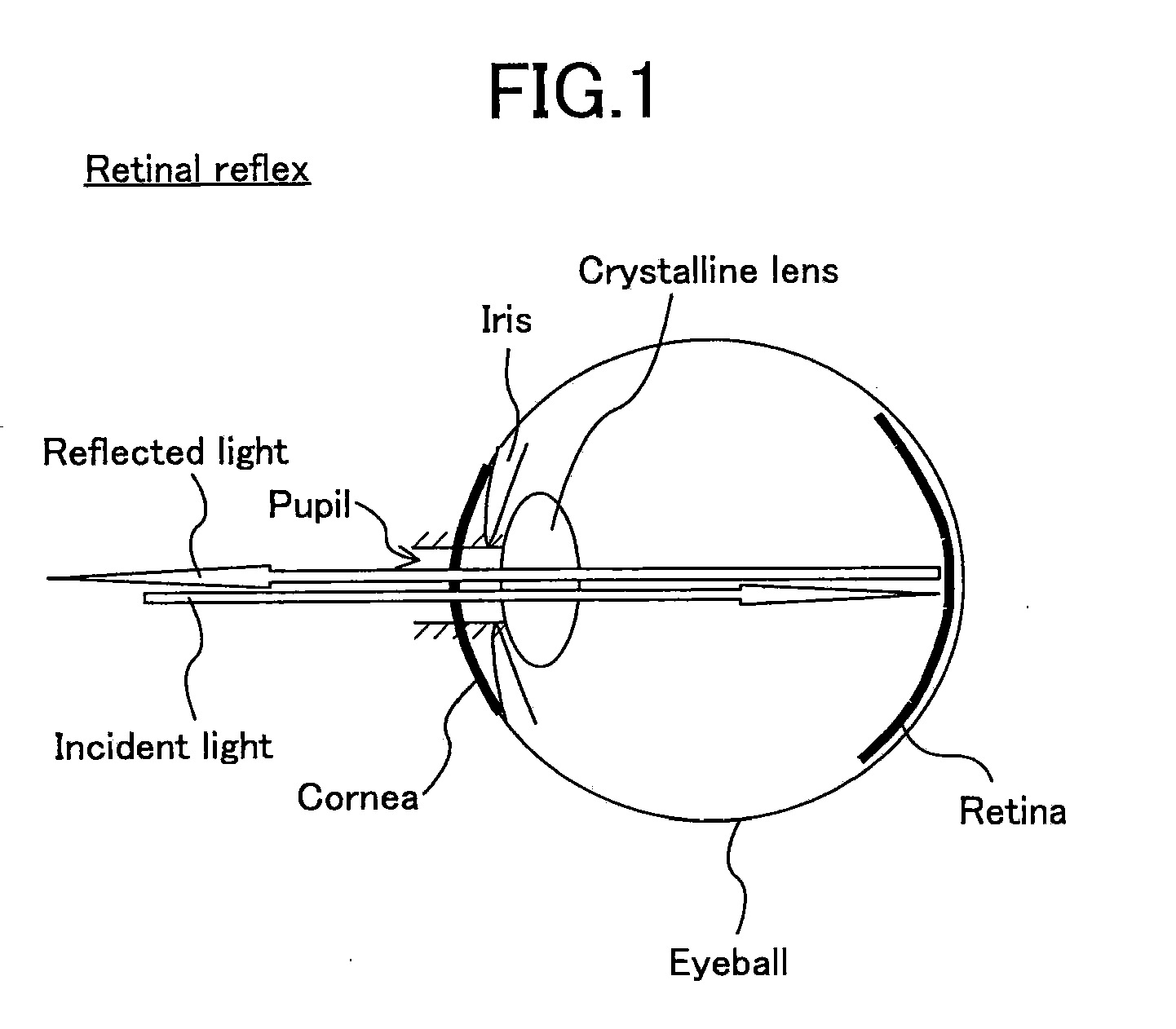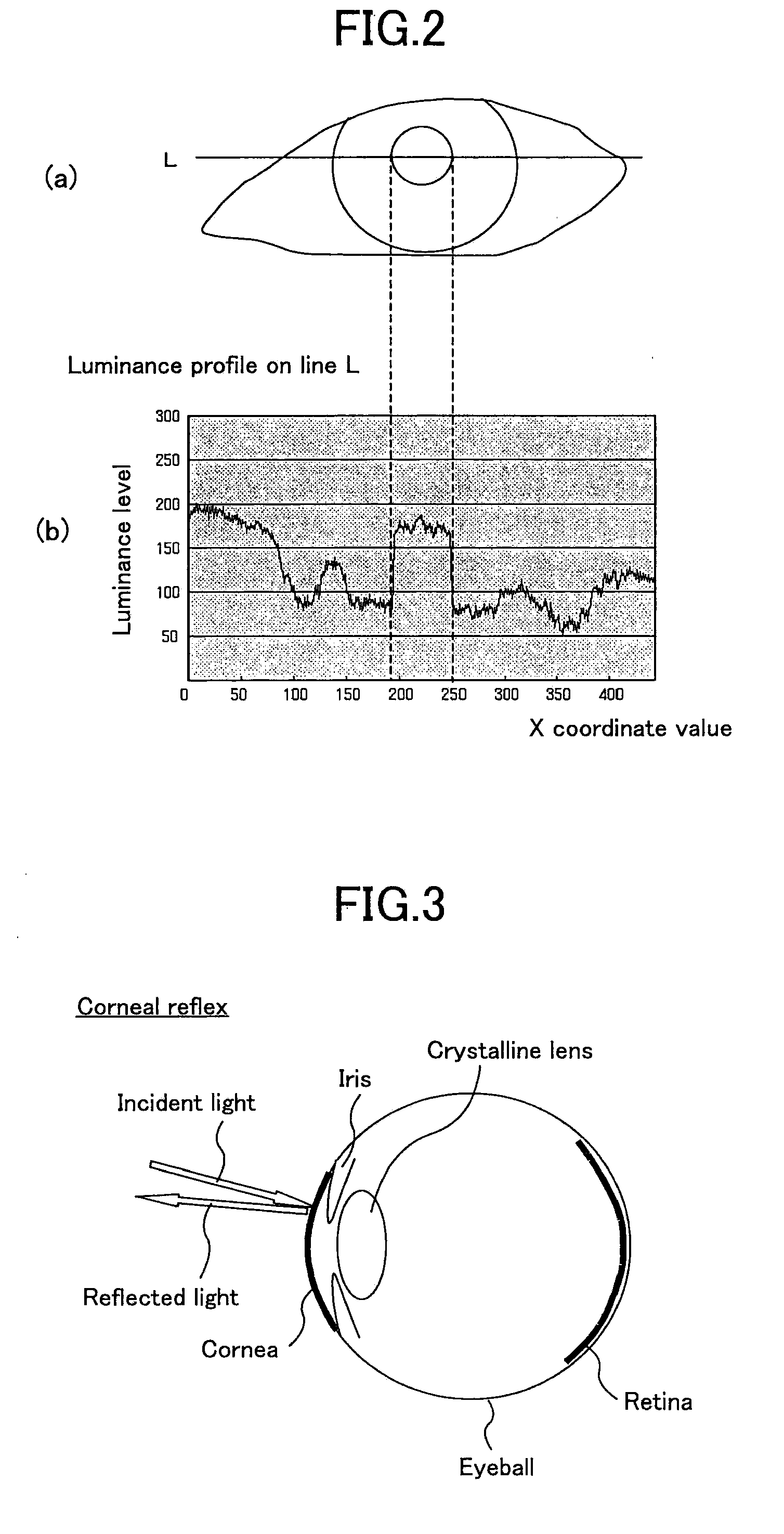Living Eye Judging Method and Living Eye Judging Device
a living eye and iris technology, applied in the field of living eye judging, can solve the problems of false authentication of iris photographs or counterfeit eyes, and achieve the effects of high luminance in the pupil region, easy to perform, and large luminance differen
- Summary
- Abstract
- Description
- Claims
- Application Information
AI Technical Summary
Benefits of technology
Problems solved by technology
Method used
Image
Examples
first embodiment
[0055]FIG. 4 is a flowchart showing an iris authentication method according to the first embodiment of the present invention. The flow of FIG. 4 includes steps S14 and S15 of performing living eye judgment.
[0056]FIG. 5 shows one example of the constitution of an iris authentication device according to the present embodiment. In FIG. 5, a shooting device 10 is provided with a camera 11 for shooting an eye EY (a subject) of a person to be shot, an illumination 12 and a half mirror 13. Light emitted from the illumination 12 is reflected on the half mirror 13 to illuminate the eye EY. The camera 11 captures an image of the eye EY through the half mirror 13 when the subject is illuminated by the illumination 12. At this time, the optical axis of the camera 11 is coaxial with that of the illumination 12 (coaxial incident illumination). In this way, the illumination 12 and the half mirror 13 composes illumination means 19. An image processing section 15 is provided with an iris authenticat...
second embodiment
[0095]An iris authentication method according to the second embodiment of the present invention is the same in the basic processing flow as in the first embodiment. It is the difference that living eye judgment is performed in such a manner that a second image is obtained by shooting a subject with illumination of which optical axis is different from the optical axis of a camera separately from a first image obtained by shooting the subject with illumination coaxial with the optical axis of the camera and the first and second images are used.
[0096]FIG. 17 shows one example of the constitution of an iris authentication device according to the present embodiment, wherein the same reference numerals as in FIG. 5 are assigned to the common constitutional elements in FIG. 5. Different from the shooting device 10 in FIG. 5, a shooting device 20 in FIG. 17 is provided with an illumination 21 in addition to the illumination 12. The illumination 21 illuminates the eye EY of a person to be sh...
third embodiment
[0116]The basic processing flow of an iris authentication method according to the third embodiment of the present invention is the same as that in the first embodiment. It is the difference therefrom that a plurality of images are obtained in shooting of a subject with the illumination coaxial with the optical axis of the camera and living eye judgment is performed using the plural images.
[0117]The device in FIG. 5 is used as an iris authentication device according to the present embodiment, likewise the first embodiment. The constitutional elements in FIG. 5 are the same as those in the first embodiment, and the description thereof is omitted.
[0118]The processing in the present embodiment will be described with reference to the flow of FIG. 4. Of course, the living eye judgment may be performed before the iris authentication as shown in FIG. 7, or may be performed in parallel to the iris authentication.
[0119]First, in the step S11, the shooting device 10 shoots a plurality of iris ...
PUM
 Login to View More
Login to View More Abstract
Description
Claims
Application Information
 Login to View More
Login to View More - R&D
- Intellectual Property
- Life Sciences
- Materials
- Tech Scout
- Unparalleled Data Quality
- Higher Quality Content
- 60% Fewer Hallucinations
Browse by: Latest US Patents, China's latest patents, Technical Efficacy Thesaurus, Application Domain, Technology Topic, Popular Technical Reports.
© 2025 PatSnap. All rights reserved.Legal|Privacy policy|Modern Slavery Act Transparency Statement|Sitemap|About US| Contact US: help@patsnap.com



